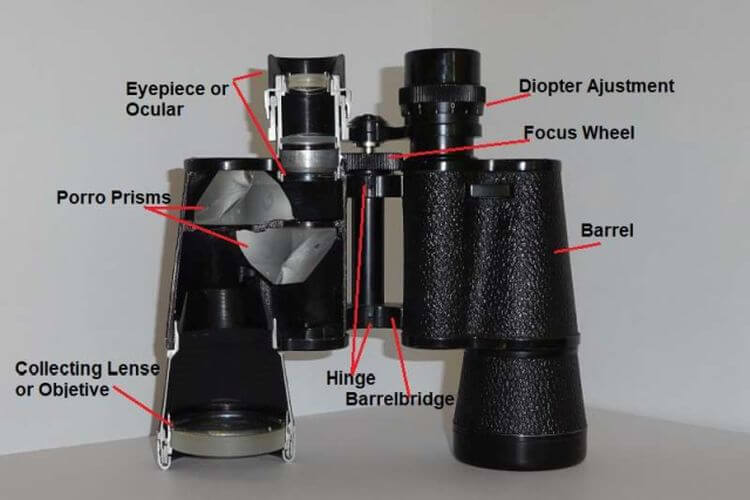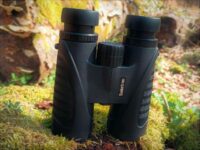If you’ve been researching about binoculars at all, you’ve probably come to the realization that while a majority of consumer binoculars come at an affordable price tag, the kind of binoculars professionals use, seem to be super high-end optics that come with all kinds of amazing features, and an incredibly large price tag to match.
This begs the question – how much different are these top-of-the-line binoculars as compared to the cheaper ones available on the market? And is all that optic technology worth paying so much for?
Why Do Professional Hunters, Ornithologists, Rangers, And Scientists Use High-End Binoculars?
If you put cheap binoculars and expensive binoculars next to each other, then the two seem pretty much the same and one has to wonder why one is so expensive and the other is so cheap.
And it doesn’t just look that way from the outside. If you cut open binoculars and take a look at the inner workings, there doesn’t seem to be a big difference between cheap consumer binoculars and premium binoculars; the basic components of binoculars are the same.

So what is the difference between cheap consumer binoculars and high-quality binoculars used by professional users?
What are high-end binoculars?
When it comes to quality optics (and that includes spectacles, sunglasses, lenses for cameras, etc), premium binoculars are pretty much at the top end of the scale for build quality, extremely meticulous workmanship, and the highest grade materials and components used.
Any high-quality optical device is built to specifications and tolerances that meet defined performance requirements, and in the case of high-end binoculars, the most precise tolerances are ultimately implemented to deliver the best possible user experience.
Defining characteristics of the best binoculars
Some of the most defining characteristics of high-end binoculars are as follows:
Use of highest quality materials in construction
The kind of materials used in manufacturing them is pretty much second to none. Prime glass is one of the key components of any optical equipment, and when it comes to binoculars, the proof really is in the pudding.
High-quality optical glass has fewer imperfections, is polished to immaculate conditions, and is designed to provide a much tighter tolerance as compared to what is found on cheaper binoculars.
This glass is also crafted and adjusted by some of the most experienced technicians in the world using advanced machinery, which promises some of the best quality workmanship that is apparent in the final product.
In addition to the glass, the housing and the precise mechanics of the moving parts also play a major role in distinguishing between high-quality and cheaper binoculars.
The body of a high-end binocular is made from expensive materials like magnesium and features all-metal internal components instead of the plastics common to inferior, cheaper binoculars. And the moving parts have to be aligned and move in sync with each other with the greatest precision.
Innovative R&D implementation
R&D is an important part of manufacturing any kind of item before it is released to the market as a commercial product. As it stands, research and development of binocular technology have come a very long way since they were first invented – the current generation of binoculars is not only a lot more compact and durable than the ones found before they combine extremely advanced and high-quality optical glasses with highly sophisticated optical coatings.
Manufacturers of high-end binoculars are constantly trying to build upon the current technology to create a newer, better pair of binoculars that have the most cutting-edge features to provide the user with the best experience. Because they have the capital and resources to do so, higher-end brands can invest a much larger amount of time and money into R&D to create better-quality binoculars.
Best optical coatings
Optical coatings play an important role in the clarity and brightness of the image that is shown through the lenses. High-end binoculars produce some of the sharpest and clearest pictures of the magnified subject or area – anything less will do a disservice to the word “high-end” anyway.
Having the best lens coatings allows for maximum levels of light input, thus giving the user an enhanced aperture on the lens of the binoculars, replicating brilliant colors and sharp outlines from up to hundreds of yards away.
This is a stark contrast to cheaper binoculars, which use lower-quality coatings on their lens and can often reproduce blurry, dark, and hazy images through the viewfinder.
Roof prisms
Roof prisms are a common feature in popular modern binoculars, because of how complicated they are to make. As compared to Porro prisms, roof prisms feature a more complex light path inside the binocular lenses, allowing for greater optical precision and thus creating sharper, clearer images.
This increase in quality translates to an increase in price, which is why you’ll often find that high-end binoculars always use roof prisms in their specifications.
Brand name
Let’s face it – whenever you’re buying any kind of product, a portion of that money that you pay goes to the brand name that you’re buying into as well. Even so, one has to consider how and why that brand name has become established in the first place.
Brand names are built based on their performance and how much trust consumers place in their products. So if you’re looking at a pair of high-end binoculars that use components from top-tier companies such as Carl Zeiss, Leica, Swarovski, and Nikon (to name a few), you can trust that the product you’re buying has gone through some of the strictest quality control checks before they leave the factory.
However, that’s not to say that an expensive pair of binoculars from a well-established brand is always worth the money spent – on the contrary, some lesser-known brands can give you a better deal in terms of features and the price point they offer. Thus, always do your research and try to find one that suits your budget, while having all the features that you need in a pair of binoculars.
Why do professional hunters use high-end binoculars?
Professional hunters need to stalk their prey from a faraway distance in order to avoid spooking their prey and thus resulting in an unsuccessful hunt. Oftentimes, stalking requires them to stay in one area for extended periods, surveilling the moves of their prey before they can formulate a plan to strike.
A quality pair of binoculars allows them to do this in the most effective way. A good hunter needs to observe their surroundings, and determine the species, sex, and other details about their target before they even pull the trigger – in fact, some might say that a pair of good binoculars are just as essential as the hunter’s gun.
Having the right gear gives the hunter the ability to view their target through the binoculars in great detail with minimal blurriness and haziness.
Why do ornithologists use such expensive binoculars?
An ornithologist is someone who observes birds in the wild for the benefit of science, using the methodological study of different bird species and their behaviors in their natural habitat. This is an essential part of conservation efforts, for both the bird species and the natural habitats that they live in.
However, birds are flighty creatures (literally) – when they sense a human or a threat nearby, they have the ability to immediately fly away as far as their wings can take them. Given that they wouldn’t be able to tell the difference between a professional bird researcher from a regular predator, it helps to be able to view them from a safe distance without spooking them or causing any alarm.
The use of high-end binoculars allows ornithologists to set up at distances that allow them to view the birds in their homes and study their behaviors in a much more effective way. And with the clarity, sharpness, and brilliance of colors that good birding binoculars provide the user, birdwatchers of all ages and abilities can enjoy a day out viewing these brightly colored creatures no matter where they are.
Why do rangers use high-end binoculars?
Because of the nature of their job, Rangers have to go through all kinds of weather conditions, seasons, and landscapes. Because high-end binoculars are built to withstand rugged conditions, they are a perfect piece of equipment to bring along in their kit. The coatings and materials used in high-end binoculars are both lightweight and ultra-strong, ensuring that they can withstand some serious hits and still keep performing under pressure.
Additionally, fogging can be an issue when it comes to cheap binoculars used in wet conditions in combination with sudden temperature fluctuations – but not in their high-end counterparts. Because of environmentally sealed housings and the quality of glass and lens coatings used in top binoculars, they perform reliably, no matter the weather conditions.
Why do scientists use high-end binoculars?
A scientist’s job is to observe the natural world and its phenomena, allowing them to understand and classify everything for the benefit of humankind. When it comes to binoculars, wildlife scientists are certainly one of the most regular users of high-end binoculars.
This is because high-end binoculars allow them to view wildlife in their natural habitat from a far distance away. Because most wildlife isn’t used to the presence of humans, they tend to scurry away at the sight of the animal that’s on the top of the food chain (that’s humans). Using a pair of high-end binoculars, with high magnification levels and incredibly sharp and clear image quality, allows wildlife scientists to get the best surveillance possible whenever they are out in the field.
Although watching the stars is more of a job for the telescope, some astronomers and space scientists use binoculars as an addition to their equipment bag. And when it comes to viewing space in the darkness of the night, only the highest quality materials will suffice. Just like a photo camera, binoculars work best when a maximum amount of light gets into the lenses and can reach the eyepiece as unhindered as possible. One speaks of high transmission, with lenses this is achieved through highly complex coatings – a trait that is common across all high-end binoculars, making it the best equipment to use for scientists of all disciplines.
Expensive binoculars vs cheap binoculars
Now we compare the major differences between a pair of high-end binoculars and a pair of cheaper binoculars, just to see if the price really makes a difference when you’re choosing between the two.
Build Quality
When comparing a high-end pair of binoculars to a cheaper pair, build quality is probably the first thing that will strike you between the two. On more expensive binoculars, you’ll find that it certainly looks and feels more robust to the touch, and you’ll have a sense of confidence knowing that the piece of equipment you’re holding in your hands can stand up to the rigors of wherever you’ll be taking them to without sacrificing any performance whatsoever.
Cheaper binoculars often use materials such as plastic for the housing, making it feel notably less durable.
Magnification Level
The whole point of a pair of binoculars is to magnify far-away objects. So many people who are not too familiar with optics think that premium binoculars offer a particularly high magnification.
But even the high-priced binoculars have magnifications in the range of 7, 8, or 10 times just like the cheaper consumer models. The difference, however, is that the high-priced models deliver incomparably better optical performance and much higher image quality.
Image Clarity
Higher quality optical glass and advanced dielectric lens coatings used in high-end binoculars mean that the viewing will be crystal clear and highly detailed in terms of image sharpness, color fidelity, edge sharpness, contrast-rich, without stray light or ghost images even in difficult conditions, and no or hardly noticeable optical aberration.
Fuzzy and dim images are one of the common problems you’ll find on cheap binocular options.
Ease Of Use
Although using a pair of binoculars is pretty much fool-proof, there are several functions on binoculars that can either be intuitive or just downright difficult to use. High-end binoculars often feature many extra functionalities that can completely enhance the binocular-using experience.
Components Used In Manufacture
High-end binoculars use only the best materials during the manufacturing process, giving the user only the best product as an end result. Cheaper alternatives mostly use plastic components for the housing and moving parts, while premium models use materials such as high-quality metal alloys or carbon plastics and the best optical glass to create the best user experience, no matter when and where.
Weight
Although weight may be a hallmark of a robust and well-built pair of binoculars, most binoculars tend to cut down on as much weight as possible while giving the best performance. This is to improve portability, as a pair of binoculars is a piece of equipment that the user has to carry throughout the field.
This effectively means that even though a cheaper pair of binoculars might feel heavier than a high-end pair, there’s no reason to assume that the former option is better than the latter – it all boils down to performance in the end.
Conclusion
High-end binoculars are used in many applications because of their performance and durability. This is what makes them so popular in the professional fields of hunting, ornithology, wildlife observation, and science.
However, with this high performance comes a steep price tag. One of the most important points to consider is that “high-end” binoculars will no doubt give you an outstanding experience when it comes to viewing comfort, but it doesn’t necessarily mean that you absolutely need to get a premium pair for yourself right away.
Weigh your options and do your research with other more affordable binocular choices. You might be surprised to find a good deal that suits most, if not all, of your requirements at a price point that doesn’t burn a hole in your pocket.
References



